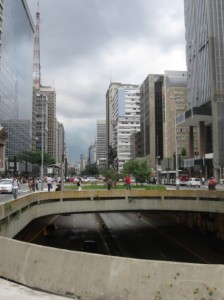
Photo © Michael Sommers.
If you had told me 10 years ago that in the midst of January I might long for a change from hot sunny weather, tropical beaches, and festas galore, I would have said you were nuts.Call me louco (some of my friends did), but after two months of beach-sprawling, festa-going and sultry tropical heat that had me in a state of perma-languor, I decided I needed a break from my hometown of Salvador, Bahia.
So I caught a cheap flight on TAM (Brazil’s reigning airline these days), and within a mere 2.5 hours I was in São Paulo – a concrete mega-city with not a grain of sand or patch of sunlight in sight. In fact, due to record rainfall, skies have been stormy gray and flooding has been endemic (although, as usual, due in part to lack of basic infrastructure and precarious constructions, most damage has been confined to poorer areas of the city).
Sampa – the name with which Paulistanos (natives of the city of São Paulo) fondly refer their home town – is a funny place to visit. I am always struck by the fact that, overall, this megalopolis of 20 million (the population of its metropolitan area) is quite ugly. Despite this triviality, over the years I’ve developed a rather large soft spot for it.
If you’re in the mood for a big city on a large scale, Sampa fits the bill. If you’re in the mood for a big city on a large scale, Sampa fits the bill. To experience the epitome of its raw bustling energy, impressive mix of architecture, and the incredible diversity of both its inhabitants and its offerings, head to the city’s main artery, Avenida Paulista (pictured above), which is what I did the first day I arrived. A rougher, messier version of Fifth Avenue or the Champs-Elysées, strolling along its 2.8-km expanse is terrifically impressive, and at the same time, somewhat overwhelming. (If you like your strolls to be relaxing, come on the weekend when the traffic is low).As you make your way from Metró Consolação to Metró Brigadeiro, there are tons of great places to stop along the way and kill some time for little or no money. Here are a few of my favorites:
At no. 2073, the elegant Conjunto Nacional, Latin America’s first shopping center, is an ideal spot to have an espresso while watching Paulistanos go by, or book browse at the fabulously revamped Livraria Cultura bookstore (where comfy bean bags and copies of Moon Brazil abound).
At no. 1578, the Museu de Arte de São Paulo (lovingly nicknamed “MASP,” and pronounced “Maspee”) ranks as one of Latin America’s best art museums. Designed by Lina Bo Bardi, the building itself – a giant glass box suspended above the sidewalk by a quartet of tomato red pillars – is an architectural icon. Currently, there is a terrific exhibition of engravings by Marc Chagall (many culled from private Brazilian collections). The subjects of the 178 works on display (until March 28) range from Biblical to the fables of La Fontaine and feature some stunning use of color. Full admission is R$15 – Tuesdays are free.
Right across the street from MASP, respite from the Avenida Paulista’s “concrete jungle” can be found amidst the small patch of real jungle (complete with cinematic bird cries) that constitutes the Parque Trianon. The formerly fashionable strolling grounds of the city’s 19th-century coffee elites, this cool oasis of green – whose present exuberance was the work of renowned landscaper Roberto Burle Marx – is a refreshing place to flake out on a bench, marvel at sky-high palms, and keep your eyes peeled for resident woodpeckers and saguis (wooly monkeys).
Paulistanos are renowned cinephiles and there is no shortage of modern movie palaces sporting vast screens along Avenida Paulista. At no. 807, Cine Gemini is a hidden gem overlooked by most Paulistanos. Tucked away in an innocuous galeria, the two-screen cinema is 1970s glamor at its most delicious with psychedelic carpets, red-tiled bathrooms, and cavernous theaters that are inevitably close to empty. Films (including many American indies) that you missed first time around often turn up here and tickets are among the cheapest in town.
Further along at no. 149, the Centro Cultural Itaú – a leading cultural center whose wildly futuristic exterior is a sight in itself – is paying homage to Chico Science, leader of the Pernambucano band Nação Zumbi (until April 4). The vanguard artist who died tragically young (at 31) in a car accident was a pioneering force in the creation of manguebeat, a movement that mixed Northeastern regional musical styles such as maracatu with hip hop, rock, and electronica. Complimenting the display of all sorts of memorabilia (including Science’s collection of funky shades) are a series of concerts, films, and other events – all of them free.